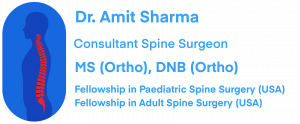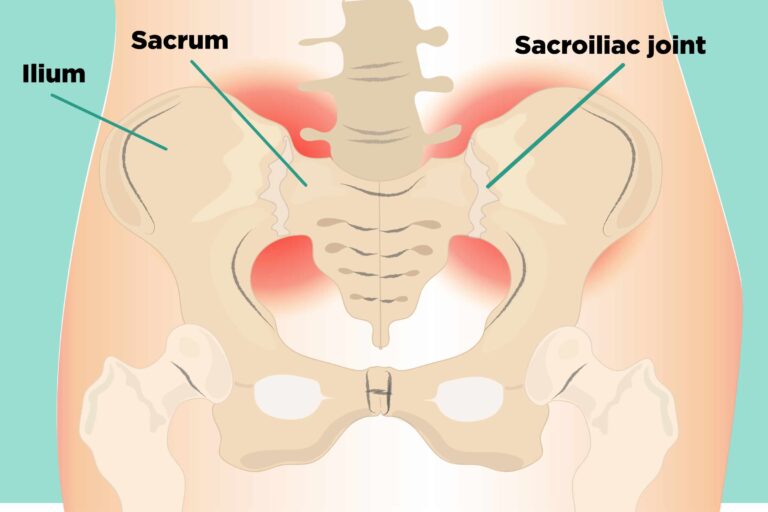Best Spine Surgeon in Mumbai | Dr. Amit Sharma

+91-9967600461
draks777@gmail.com
Sacroiliitis: Symptoms, diagnosis and treatment

Sacroiliitis: Symptoms, diagnosis and treatment
Sacroiliitis: Inflammation of SI Joint
Sacroiliitis is inflammation of one or both surfaces of sacroiliac (SI) joint. Sacroiliac joint lies between sacrum (last triangular part of the spine) and ilium (pelvic bone). One or both SI joints can be affected.
Symptoms:
Patients usually present with typical symptoms of low back pain. Pain can be more on the side of the joint affected. Pain can radiate down to buttocks or upwards in paraspinal area. Occasionally, patients have symptoms similar to slip disc with pain radiating down the leg with numbness. Pain usually worsens with activities.
Causes of Sacroiliitis:
Trauma: Any injury in the hip area can affect SI joint. A fracture involving sacrum or ilium bone going through SI joint will cause pain in the area. A mal-united fracture will lead to arthritis in SI joint.
Arthritis: Age related chronic wear and tear will cause degenerative arthritis. Various inflammatory arthritis caused by rheumatological diseases (Ankylosing Spondylitis, Reiter’s Disease, Lupus, Psoriasis) affect SI joint commonly.
Pregnancy and Childbirth: Various hormones generated during pregnancy will lead to relaxation of joints to assist in child-birth. This may stress SI joints and can leads to sacroiliitis. During vaginal childbirth, widening of pelvis may disrupt SI joint leading to sacroiliitis.
Infection: Bacterial or tubercular infections can affect Si joints.
Lumbo-sacral fusion surgeries: A fusion surgery in the lumbo-sacral area will lead to excessive stress on SI joints during weight transmission. It is not uncommon to have sacroiliitis in these patients.
Diagnosis:
A high index of suspicion is required to diagnose sacroiliitis as symptoms mimic that of lumbar spine pathologies. A local tenderness directly over sacroiliac joint will elicit pain. Certain specific physical tests to stress Si joint will cause pain on the affected side.
X-ray/ MRI/ CT Scan: X-ray will show joint arthritis and hardening of bone around SI joint. In infection, joint will be destroyed. MRI will show inflammation and infection in detail. CT scan will show roughened joint surfaces.
Blood Tests: ESR and CRP will be elevated in inflammatory and infectious arthritis. Positive HLA B-27 will help in diagnosing Ankylosing Spondylitis.
Anesthetic Injection: A local anesthetic injection given inside the joint should relieve pain coming from SI joint. It is either done under fluoroscopy guidance in operation theater or under CT guidance.
Treatment:
Primary treatment of sacroiliitis is same as that of any patient with back pain. Local application of heat/ cold, pain medicines and physiotherapy provides relief in majority of the patients. Some amount of activity restriction and activity modification is required to prevent aggravation of symptoms.
Local Steroid Injection: For degenerative and inflammatory sacroiliitis, a mixture of local anesthetic with small dose of steroid can be injected under fluoroscopy or CT guidance. This will reduce inflammation in the joint and will provide long lasting relief from pain.
Biopsy: In suspected infective sacroiliitis, a biopsy (fluoroscopy or CT guided) if required to find the nature of infection and effective antibiotic treatment.
Radiofrequency (RF) Ablation: RF ablation is a pain management procedure in which tiny nerves supplying the Si joints are ablated by radiofrequency, so pain from inflamed Si joint is not perceived.
Surgery: Surgery is kept as a last resort in following situations:
- Severe pain not responding to medical line of treatment and injections
- Fracture involving sacroiliac joint
- Infective sacroiliitis: To take biopsy (if fluoro/ CT guided biopsy was negative) and to debride the joint (if not responding to antibiotics).
Usually a sacroiliac joint fusion surgery is performed, in which the joint is debrided and bone grafted. Various internal fixation devices are available which helps achieve the fusion.
Pain in SI joint Sacroilits
What you want to know?
Though, I am off topic but as I have recently been diagnosed with the condition Bertollottis syndrome Type 2B, I wanted to know if Resection procedure is done anywhere in India to trim the extra LSTV bones touching, grinding or even fusing with the sacrum as well as the Ilium bilateral. I am aware of L5-S1 fusion procedure but afraid of getting it done because of various future issues that might happen so if possible would want to have a resection first. Though, so far I have failed to identify any surgeon here in India who has experience in Resection procedures or enough knowledge about Bertollottis syndrome. Sir, please get back if you or any one else that you know of, could help me in this regard I am out of options and desperate to get OK as it has been 30 years that I have been suffering with this condition and that too without getting correctly diagnosed. I will be obliged and indebted to for the rest of my life. My ph. No. is 9814292002
I think we have already connected on whatsapp.
Bertolotti’s Syndrome is a common condition. Resection is one of the option. It is a very easy and straight forward procedure. However, results are not as predictable as L5-S1 fusion. L5-S1 fusion is gold standard technique for Bertolotti’s Syndrome. This can also be done in a minimally invasive way with a very quick recovery.
In the nuanced arena of sacroiliitis, the distinction between lumbar pathologies and actual SI joint inflammation is pivotal. Indeed, sacroiliitis offers a unique clinical picture, sometimes echoing the presentations of other back-related ailments. The emphasis on diverse causative factors, from trauma and arthritis to the physiological changes during pregnancy, underscores the multifaceted nature of this condition. As with most clinical scenarios, accurate diagnosis hinges on a blend of clinical acumen aided by imaging and relevant blood markers. A timely, conservative, or more invasive therapeutic intervention like steroid injections can profoundly impact patient outcomes. The discourse on sacroiliitis serves as a reminder of the complexity embedded in seemingly straightforward musculoskeletal complaints.
I have si joint pain but nothing shows in mri and x-ray. I am almost bed ridden from past 3 years. Is there anything that can help me.
Please send all reports on draks777@gmail.com